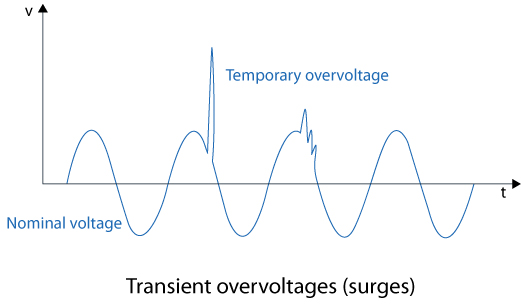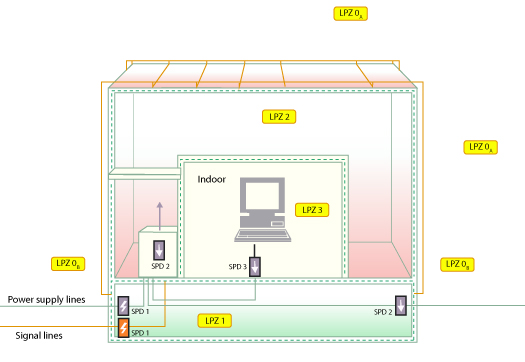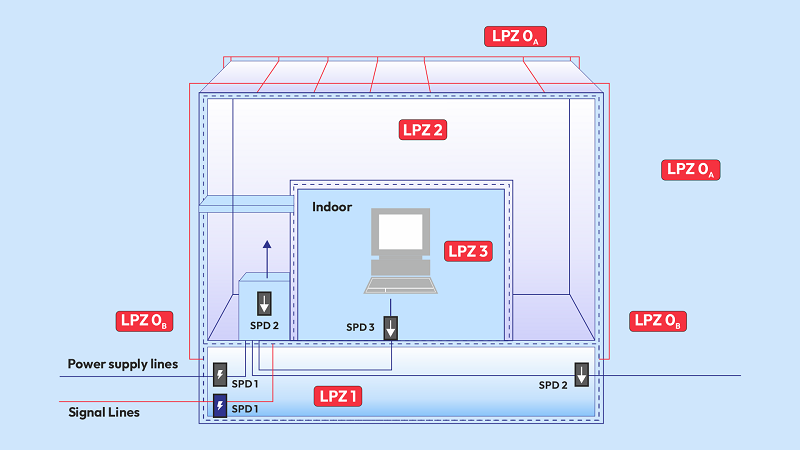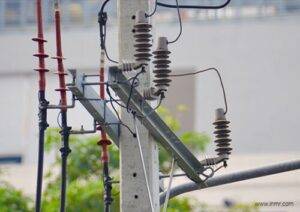As we described in our previous blog, ‘Lightning Protection System Design and Products’, Surge Protection Devices or SPD’s are an important part of any building’s Internal Lightning Protection System (LPS). SPD’s are designed to protect sensitive electronic & electrical equipment by limiting transient overvoltage and diverting surge currents. SPD’s are the most efficient and commonly used type of overvoltage protection for an facility or load below low voltage range.
Malfunctions or damage to electrical devices can occur when a surge voltage exceeds that device’s dielectric strength. These kinds of surge voltages with very high amplitudes in the kilovolt range, are usually transient, meaning that they range from a few microseconds to several hundred microseconds. These short durations with high amplitudes cause sudden voltage increases and whose effects can only be protected against by surge protection devices. Surges such as these most likely caused by lightning strikes (direct or indirect), switching operations and electrostatic discharges.
Relevant Standards: UL 1449: Standard for Surge protection devices (SPD), IEC 62305: Lightning protection standard, IEC 61643: Low-voltage surge protective devices
How do SPD’s Protect against Overvoltage:

SPD’s are designed to limit the surge voltage in terms of amplitude so that the dielectric strength of the device is not exceeded and additionally to discharge the surge currents associated with surge voltages to a distant ground. They perform these activities while connected either in parallel to the equipment, between the active conductors or between the active conductor and the protective conductor. Whenever there is excess charge or surge in the system, the SPD behaves like a switch and turns off (i.e. has low resistance) so that the surge current bypasses the sensitive equipment and flows to the earthing system. Once the surge is over, the SPD opens up and the equipment and system will work smoothly again.
Lightning Protection Zones:

The placement of SPD’s within an electrical system is determined using the Lightning Protection Zones determined for the structure as defined in IEC 62305 Part 4. The external zones (LPZ 0a and LPZ 0b) can only house surge resistant equipment while the internal zones can house sensitive equipment such as medical equipment.
LPZ 0A: Unprotected zone outside of a building where direct lightning strikes are possible.
LPZ 0B: Zone outside the building that is protected from direct lightning strikes, for example, by an air terminal.
LPZ 1: Zone inside the building where high-energy surge voltages or surge currents and strong electromagnetic fields are still to be expected.
LPZ 2,…., n: Zone inside a building where surge voltages or surge currents and electromagnetic fields that have already been significantly weakened are to be expected.
Types of SPD’s and their Application
As per IEC 62305, standard SPD’s are divided into the following categories:
1) Type 1:
The Type 1 SPD is recommended in the specific case of service-sector and industrial buildings, protected by a lightning protection system or a meshed cage. It protects electrical installations against direct lightning strokes. It can discharge the back-current from lightning spreading from the earth conductor to the network conductors. This means that they are installed where there is a change from Zone 0 to Zone 1 such as the entrance of an electrical line into a building.
2) Type 2:
Type 2 SPD’s are the main protection system for all low voltage electrical installations. Installed in each electrical switchboard, it prevents the spread of overvoltages in the electrical installations and protects the loads. This means that they are installed in Zone 1 or higher.
3) Type 3:
These SPDs have a low discharge capacity. They must therefore mandatorily be installed as a supplement to Type 2 SPD and in the vicinity of sensitive loads. This means that they are installed in Zone 2 or higher.
Watch this video to understand the Types in detail
Characteristics of SPD

IEC 61643 Part 11, defines the characteristics and tests for SPD’s connected to lower voltage distribution systems.
Uc: Maximum continuous operating voltage
The SPD becomes active above this A.C. or D.C. voltage. The rated voltage and the system earthing arrangement helps determine this value.
Up: Voltage protection level (at In)
When the SPD is active, this is the maximum voltage across its terminals. when the current flowing in the SPD is equal to In the voltage reached is Up. The voltage protection level chosen must be below the overvoltage withstand capability of the loads. In the event of lightning strikes, the voltage across the terminals of the SPD generally remains less than Up.
In: Nominal discharge current
This is the peak value of a current of 8/20 μs waveform that the SPD is capable of discharging 15 times.







